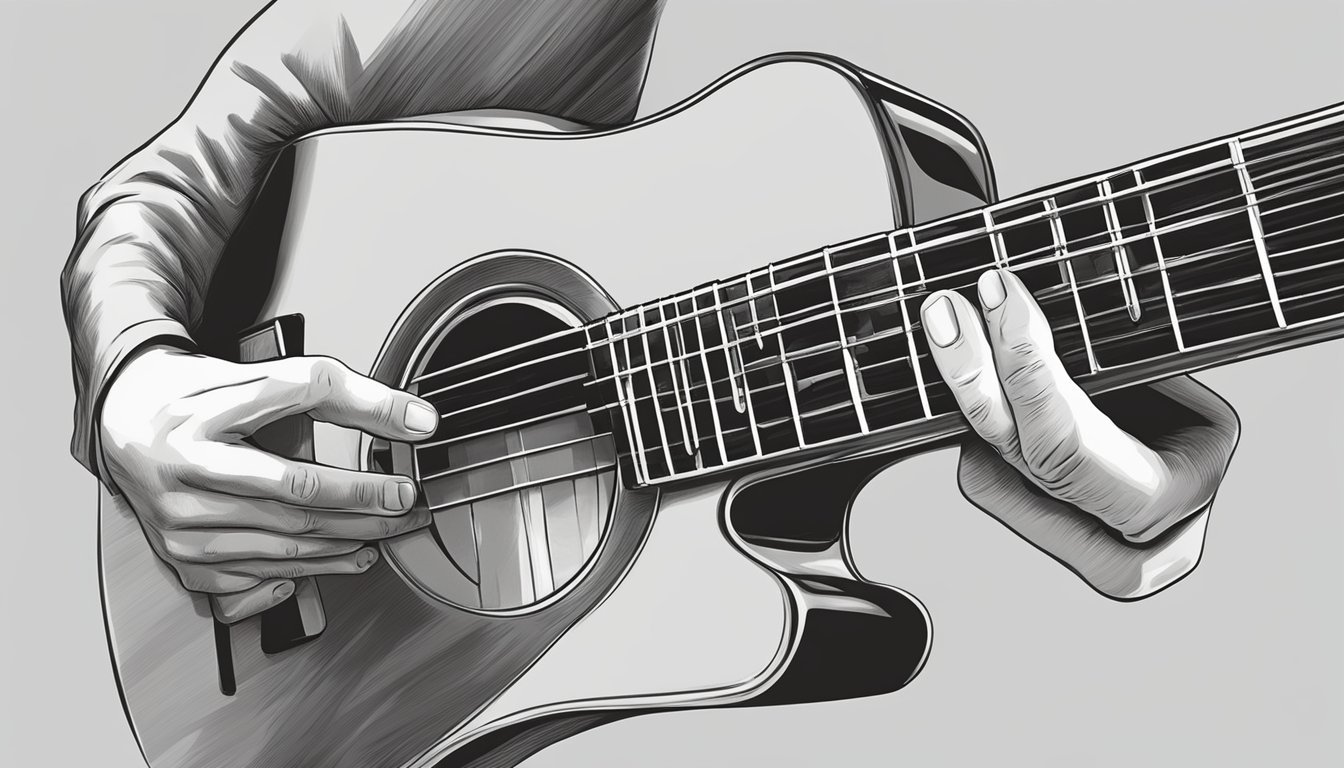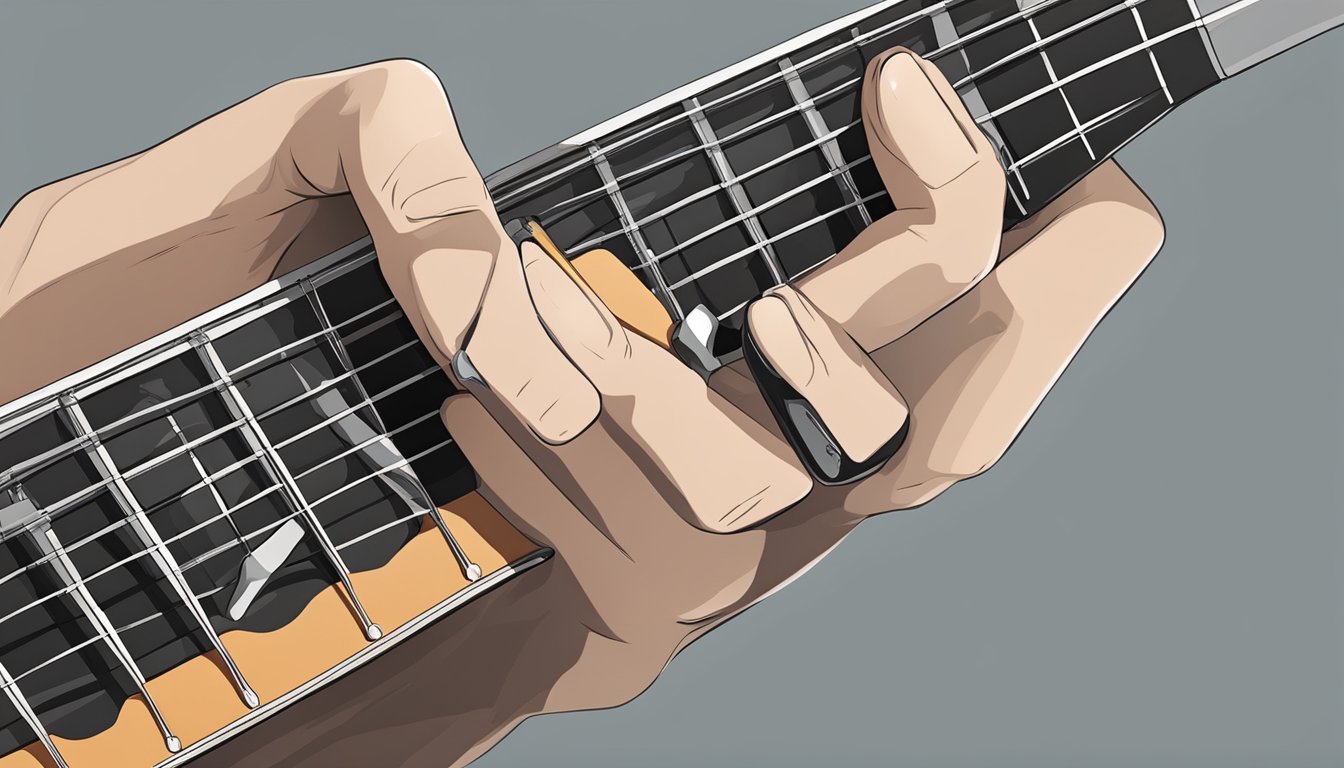Playing the guitar opens up a world of music, and mastering basic chords is your first step.
The C chord is one of the essential chords to learn, as it forms the foundation for countless songs.
Once you get the hang of it, you’ll feel more confident and ready to explore more complex chords and progressions.

In this article, you will learn exactly how to play the C major chord.
We’ll break down the finger placements and give you tips on strumming.
Plus, you’ll discover effective ways to practice and transition between different chords smoothly.
By the end, you’ll be ready to add the C chord to your repertoire and play along with your favorite tunes.
Let’s get started on this musical journey!
Key Takeaways
- The C chord is an essential building block for beginner guitar players.
- Proper finger placement is key to mastering the C major chord.
- Regular practice helps improve chord transitions and overall playing skills.
Getting to Know the C Chord
The C chord is one of the first chords many guitarists learn.
It’s an open chord, which means you play some strings without pressing down on them.
Understanding its structure can really help you play it smoothly.
Understanding the Basics of Chords
Chords are combinations of notes played together.
The C chord is part of the major scale, which consists of a specific pattern of whole and half steps.
In the case of the C major scale, the notes are C, D, E, F, G, A, and B.
The C chord uses three main notes: C, E, and G. To form this chord, you combine these notes in a specific way.
The C note is the root, the E note is the major third, and the G note is the perfect fifth.
These notes together create a happy and bright sound.
The Components of a C Chord
When you play an open C chord, you press down on the first fret of the B string and the second fret of the D and A strings.
Your pointer finger goes on the B string, while your middle and ring fingers press the D and A strings.
The high E string remains open.
The intervals in your C chord help create its distinct sound.
The distance from C to E is a major third.
From E to G, the interval is a minor third.
These intervals are key in giving the C chord its bright character.
Practicing this chord is essential for switching between other chords.
With some patience, you can incorporate this chord into many songs!
Playing the C Chord: Step-by-Step
Playing the C chord is one of the first steps for beginners.
It sets the foundation for many songs and can be played in different ways.
Let’s look at how to place your fingers correctly and explore some variations.
Finger Placement and Techniques
To play the C chord effectively, start by focusing on your finger placement.
Place your index finger on the 1st fret of the B string (2nd string).
Next, your middle finger should go on the 2nd fret of the D string (4th string).
Finally, position your ring finger on the 3rd fret of the A string (5th string).
When strumming, avoid hitting the low E string (6th string) unless you want a fuller sound.
Strum from the A string down to the high E string (1st string).
This will produce a clear C major sound.
Make sure each note rings clearly by plucking the strings individually if needed.
Variations of the C Chord
The C chord has several variations that you can experiment with.
One common variation is the Cadd9 chord.
To play this, add your pinky to the 3rd fret of the high E string (1st string) while keeping your other fingers in their original positions.
It adds a nice flavor to your playing.
Another option is the C7 chord.
For this one, keep your current finger positions but add your pinky to the 3rd fret of the G string (3rd string).
This creates a bluesy sound perfect for many styles.
If you’re feeling adventurous, try the C/G chord by playing the standard C chord but with your ring finger on the 3rd fret of the low E string.
This can give a fuller sound on an acoustic guitar.
Explore these variations to find what you like best! To further enhance your sound, consider transitioning between the C/G chord and other variations, like G or D. This fluidity will not only enrich your playing but also improve your overall rhythm.
Remember, the key to mastering these changes is practice, so take your time and enjoy the process as you learn to play an A chord on guitar.
Mastering Transitions and Progressions
Getting comfortable with chord transitions and progressions is key to playing the guitar smoothly.
This skill helps you shift between chords like the C major, G, and D chords effortlessly.
With practice, you can add depth to your music.
Transitioning Between Chords
When you move from the C chord to other chords, finger placement matters.
Start by lifting your fingers off the strings and positioning them on the next chord.
For example, when going from the C chord to the G chord, keep your index and middle fingers close to their original positions to make the change quicker.
Practice each transition slowly.
Gradually speed up as you feel more comfortable.
A good method is to focus on one chord change at a time.
Repeat the C to G transition until it feels natural.
Another tip is to use a metronome.
Set a slow tempo and work on changing chords on each beat.
This will help you develop timing and confidence in your chord changes.
Incorporating the C Chord into Progressions
To create a chord progression in the key of C, the C major chord is your starting point.
A popular progression is C – G – Am – F. Each chord flows into the next, making your playing sound cohesive.
Begin by practicing the progression slowly.
Strum each chord for four counts before moving to the next.
This gives you time to position your fingers correctly.
Once you feel comfortable, try strumming a bit faster.
You can also experiment with variations.
For example, try adding a D chord into the mix or create your own patterns.
Using the open C chord shape allows you to move smoothly between chords while keeping your sound bright.
With consistency, you’ll master these transitions and progressions in no time.
Enhancing Your Practice

Improving your C chord playing takes focus and the right techniques.
By using effective practice methods and learning from lessons, you can make steady progress.
Effective Practice Techniques
To master the C chord, set specific goals for each practice session.
Start by dedicating 10-15 minutes just to finger placement.
Use a metronome to keep a steady rhythm.
Begin slowly, then gradually increase your speed as you gain confidence.
Consider practicing these tips:
- Warm up your fingers: Play simple scales before diving into chords.
- Visualization: Picture your fingers on the fretboard to reinforce muscle memory.
- Record yourself: Listening to your playing can highlight areas for improvement.
For more advanced practice, try transitioning between the C chord and other chords like G or D. This will help you move smoothly and build confidence in your playing.
Learning from Guitar Lessons
Taking guitar lessons can be incredibly helpful.
You can find both in-person and online options, which are great for beginners and acoustic players.
A teacher can provide personalized tips and feedback, especially on the C major 7 chord and its variations.
When selecting lessons, look for:
- Structured curriculum: This helps you build skills step by step.
- Focus on the basics: Ensure the lessons cover fundamental chords and strumming patterns.
- Interactive content: Some platforms have play-along tracks that make practice more enjoyable.
Don’t hesitate to ask your instructor for additional resources to reinforce what you learn in each session.
Frequently Asked Questions
Learning the C chord can be tricky at first, but with practice and the right tips, you can master it.
Here are some common questions that can help you along the way.
What’s the easiest way to get the C chord down for newbies?
To start off easy, use your ring finger on the third fret of the A string.
Your middle finger goes on the second fret of the D string, and your index finger should be on the first fret of the B string.
This version requires minimal finger movement, making it great for beginners.
Any tips for mastering the finger position for a C chord?
Make sure you’re pressing down firmly with your fingers.
Use the tips of your fingers to avoid muting other strings.
Practice slowly at first, then gradually speed up as you get more comfortable with the shape.
What strings do I strum for a clean-sounding C chord?
You should strum from the A string down to the high E string.
Avoid hitting the low E string; while it’s part of the chord, it’s better to focus on the top five strings for clarity.
I’m struggling with the C chord, can you show me a step-by-step?
- Place your ring finger on the 3rd fret of the A string.
- Put your middle finger on the 2nd fret of the D string.
- Align your index finger on the 1st fret of the B string.
- Strum from the A string down and ensure each note rings clearly.
Is there a common mistake to avoid when playing a C chord?
A common mistake is strumming the low E string.
This can make the chord sound muddy.
To keep the sound clean, focus on strumming only the top five strings.

